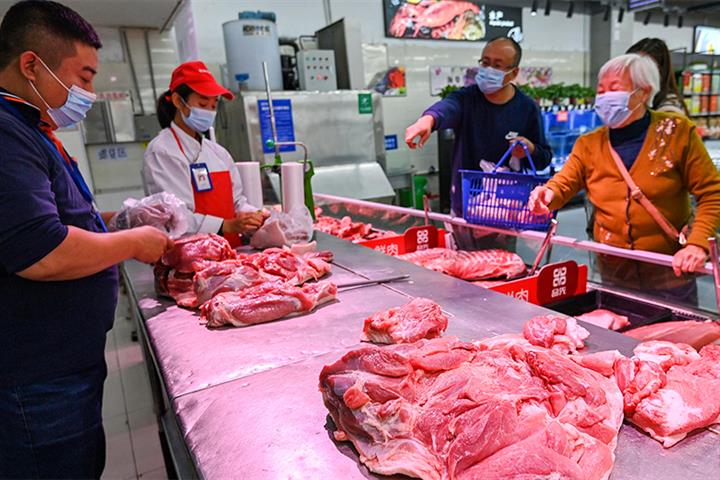 Price of Pork Falls in China as Market Glut Fails to Clear in Run Up to Lunar New Year Break
Price of Pork Falls in China as Market Glut Fails to Clear in Run Up to Lunar New Year Break(Yicai Global) Jan. 12 -- China’s pork prices have been sliding for the last three months, even though the Lunar New Year, a major holiday and normally a peak period of pork consumption, is approaching. The oversupply is likely to do with a lack of demand as people opt to stay home amid a new wave of Covid-19, a market analyst said.
The number of live hogs on the market has been increasing since the beginning of the year, yet demand has been quite weak, leading to the continuous drop in prices in most parts of the country, according to the latest market report from the Ministry of Agriculture and Rural Affairs.
Many people are staying at home amid the latest flare-up which started early last month, either because they are sick or because they don’t want to catch it, Feng Yonghui, an analyst at Soozhu, told Yicai Global. This has led to a marked drop in demand for pork.
The average price of live hogs had fallen to CNY15.36 (USD2.27) per kilogram on Jan. 10, almost half the record high set in the middle of October of CNY28 (USD4.10) per kg, according to pork trading information site Soozhu.
While the average price of lean pork slumped 12.9 percent in the week ended Jan. 6 from the week before to CNY20.05 (USD2.97) per kg, according to the ministry. This was also a 0.9 percent year on year dip.
The hog-corn price ratio fell to 5.93:1 in the week ended Jan. 6, below the breakeven point of 6:1, meaning that pig breeders are now losing money, according to the latest monitoring data from the National Development and Reform Commission. The larger the ratio, the more profit for the pig farmers, but the smaller the figure, the less they are earning.
A year ago, pig breeders were making an average profit of CNY1,000 (USD148) per hog, but now they are losing around CNY300 (USD44) per swine, Feng said. If the slaughtering of the pigs is delayed, the deficit can even reach CNY1,500 (USD222) for each animal, he added.
Oversupply
The price swings have to do with the Covid-19 outbreaks, Feng said. Many areas introduced pandemic prevention measures that affected the transportation of live hogs, delaying their delivery to market. This led to a big surge in live hog prices between June and October last year and then resulted in the ensuing oversupply after October.
While pigs are still arriving as scheduled on the market, there remains a big backlog from before which has led to a market glut and brought about the sharp fall in prices, he said.
The price of pork is likely to stay low in the run up to Chinese New Year at the end of the month, Feng said. Whether it picks up after that depends on how quickly the existing inventory can be used up.
Economic Indicator
The price of pork is a key economic gauge to which the government and economists pay close attention and its movements affect the country’s consumer price index, a measure of consumer inflation.
China’s consumer prices climbed 1.8 percent in December year on year, according to the latest data released by the National Bureau of Statistics released today. The CPI rose 1.6 percent in November.
Food prices jumped 4.8 percent year on year, contributing a 0.87 percentage point gain in the CPI. Pork price soared 22.2 percent, slowing from a 34.4 percent surge in November.
However, month-on-month, pork prices tumbled 8.7 percent in December, much more than November’s 0.7 percent dip as more pork flooded the market. December’s monthly CPI was unchanged from November’s.
Editors: Tang Shihua, Kim Taylor